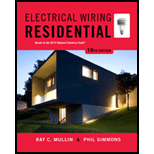
Electrical Wiring Residential
18th Edition
ISBN: 9781285170954
Author: Ray C. Mullin, Phil Simmons
Publisher: Cengage Learning
expand_more
expand_more
format_list_bulleted
Concept explainers
Question
Chapter 18, Problem 15R
To determine
Pick the correct choices in the given statement.
Expert Solution & Answer
Trending nowThis is a popular solution!

Students have asked these similar questions
2. For each of the following transfer functions,
G(s) = Y(s)/U(s), find the differential equation
relating the input u(t) to the output y(t).
(s+2)(s+3)
(a) G(s) =
(s+1)(s+4)
(s²+0.4s+1.04) (s+3)
(b) G(s)=
(s2+0.2s+1)(s+2)(s+4)
Don't use ai to answer I will report you answer
5. A schematic diagram of a motor connected to
a load by gears is shown. Both the motor and
the load are modeled as rotating masses with
viscous damping. Find the transfer functions
Øm/Tm and ØL/Tm.
bm
Jm
Tm 0m
N₂
N₁
OL
но
JL
b₁
Chapter 18 Solutions
Electrical Wiring Residential
Ch. 18 - a. What circuit supplies the workshop lighting?...Ch. 18 - Prob. 2RCh. 18 - a. How is EMT fastened to masonry? _______________...Ch. 18 - What type of luminaires are installed on the...Ch. 18 - Prob. 5RCh. 18 - To what circuit are the smoke detectors connected?...Ch. 18 - Is it a Code requirement to connect smoke...Ch. 18 - Prob. 8RCh. 18 - Prob. 9RCh. 18 - Prob. 10R
Ch. 18 - Adjustment factors for conductor ampacities must...Ch. 18 - Prob. 12RCh. 18 - Prob. 13RCh. 18 - Calculate the total current draw of Circuit A17 if...Ch. 18 - Prob. 15RCh. 18 - A conduit body may contain splices if marked with...Ch. 18 - What size box would you use where Circuit A17...Ch. 18 - List the proper trade size of electrical metallic...Ch. 18 - According to the Code, what trade size EMT is...Ch. 18 - a. When more than three current-carrying...Ch. 18 - Prob. 21RCh. 18 - For laundry equipment in basements, what sort of...Ch. 18 - Prob. 23RCh. 18 - A Type NM cable carries a branch circuit to the...Ch. 18 - Prob. 25RCh. 18 - The following is a layout of the lighting circuits...Ch. 18 - Prob. 27RCh. 18 - Prob. 28R
Knowledge Booster
Learn more about
Need a deep-dive on the concept behind this application? Look no further. Learn more about this topic, electrical-engineering and related others by exploring similar questions and additional content below.Similar questions
- 3. Find the transfer function X2/F of the mechanical system in Figure. Κι www b₁ M₁ K2 www M2 b2 X2 F b3arrow_forwardS1(t) Es/Ts 0 S3(t) 0 Es/Ts Ts t S2(t) Es/Ts 0 Es/Ts Ts |7|2 S4(t) Es/Ts t Ts t 0 Ts Ts Ts Es/TS 2 1/ Q1(t) 42(t) Ts 1JT 0 t 0 Ts Ts 2 32 FIGURE 7.3 Set of signals and orthonormal functions for Example 7.1. 53(t)=√√Esq₁(t) S4(t)=-√E542(t) t Tsarrow_forward1. For each of the following differential equations, determine the transfer function Y/U. Determine if the transfer function is proper or strictly proper. is not strictly proper, determine the strictly proper part. If it (a) y(3) = -3y(2) - 3y(1) — 2y + u(2) — - (b) y(3)=-3.5y(2) — 3.5y(1) — y +u(3) — 3.5u(2) + 3.5u(¹) + 3uarrow_forward
- .4. Find the transfer function Ø2/T of the mechanical system in Figure. TG K 02 b₁ b₂ b3arrow_forwardMatlab problem: 1) A BFSK signal is transmitted through a channel with AWGN. Generate similar BFSK received signal plots as shown below. (20 pts) BFSK for eb=1 and npower=0.01 with 500 samples BFSK for eb=1 and npower=0.1 with 500 samples 2.5 2.5 2 1.5 1 0.5 0 -0.5 -1 2 1.5 1 0.5 0.5 -1 -1.5 1.5 -1.5 -1 -0.5 0 0.5 1.5 2 2.5 -1.5 -0.5 0 0.5 1 1.5 2 2.5arrow_forwardexample 7.1 question EXAMPLE 7.1Consider the signals s1(t), s2(t), s3(t), and s4(t) shown in Figure 7.3. Using the Gram-Schmidt orthogonalization procedure, determine a set of orthonormal basis functions.Using the waveforms derived and shown in Example 7.1:a) Sketch the simplified block diagram of the transmitter and receiver as shown in figure 7.2b) Estimate the receive voltages for each transmit signal and for each branch in the receiver.arrow_forward
- EXAMPLE 7.2 Consider the two equally-likely signals s₁ (t) and s2(t) that are transmitted, over an AWGN channel with the noise power spectral density of No/2, to represent bits 1 and 0, where we have: S1(t)=-S2(t)=√√2 exp(-2t)u(t) The receiver makes its decision solely based on observation of the received signal over a restricted interval of interest. Determine the average bit error rate in terms of Q-function, assuming the interval is [0,3]. Contrast numerically with the performance of an optimum receiver that observes. all the received signal, i.e., the interval of interest is (-∞, ∞).arrow_forward1) Compute the voltages at each receiver branch (Vo ad V₁ see block diagram next page) for each of the possible transmitted signals: Transmitted signals are generated as shown below: Binary wave in unipolar form (a) With basis functions: Inverter 41(t) Product modulator Product modulator 42(t) BFSK + signal + Si(t) P1(t)= √Eb = cos (2лfit+0₁) $2(t) 42(t)= √Eb 层 cos (2лf2t+ t+02) Generating signals: 2E Si(t) cos (2лfit+0₁), bit=0 Ть SBFSK (t) 2E |$2(t)= cos (2лf2t+02), bit=1arrow_forwardFind the disruptive voltage and visual corona voltage for 3-phase line consisting of 2.5 cm diameter conductor spaced equilateral triangular formation of 4 m. The following data can be assumed, temperature 25°c, pressure 73 cm of mercury, surface factor 0.84, irregularity factor 0.72.arrow_forward
- A 3-phase, 4-wire distributor supplies a balanced voltage of 400/230 V to a load consisting of 8 A at p.f. 0-7 lagging for R-phase, 10 A at p.f. 0-8 leading for Y phase and 12 A at unity p.f. for B phase. The resistance of each line conductor is 0.4 2. The reactance of neutral is 0.2 2. Calculate the neutral current, the suppl voltage for R phase and draw the phasor diagram. The phase sequence is RYB. VR Phasor diagramarrow_forwardThe three line leads of a 400/230 V, 3-phase, 4-wire supply are designated as R, Y and B respectively. The fourth wire or neutral wire is designated as N. The phase sequence is RYB. Compute the currents in the four wire when the following loads are connected to this supply: From R to N: 25 kW, unity power facto. From Y to N: 20 kVA, 0-7 lag. From B to N: 30 kVA, 0-6 lead.arrow_forward2) Is the following set of basis functions orthogonal? 41(t) = √== cos (2Ãfet), 0 ≤1≤T₁ P2(t)= - \ con(A). 2 VTS sin (2лfet), 0arrow_forwardarrow_back_iosSEE MORE QUESTIONSarrow_forward_ios
Recommended textbooks for you
 EBK ELECTRICAL WIRING RESIDENTIALElectrical EngineeringISBN:9781337516549Author:SimmonsPublisher:CENGAGE LEARNING - CONSIGNMENT
EBK ELECTRICAL WIRING RESIDENTIALElectrical EngineeringISBN:9781337516549Author:SimmonsPublisher:CENGAGE LEARNING - CONSIGNMENT

EBK ELECTRICAL WIRING RESIDENTIAL
Electrical Engineering
ISBN:9781337516549
Author:Simmons
Publisher:CENGAGE LEARNING - CONSIGNMENT